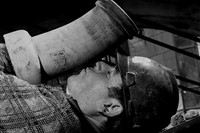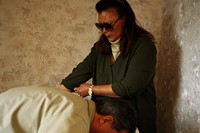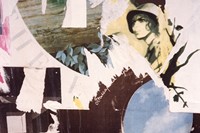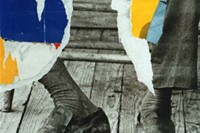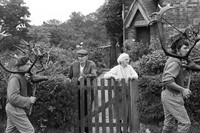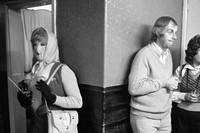"History is a cyclic poem written by time upon the memories of man". This line, taken from Shelley’s A Defence of Poetry, is the title and inspiration for the latest iteration of Photo50...
"History is a cyclic poem written by time upon the memories of man". This line, taken from Shelley’s A Defence of Poetry, is the title and inspiration for the latest iteration of Photo50, a fifty-work exhibition that is part of London Art Fair. Curated by Nick Hackworth of Paradise Row, this year the works of the eight photographers muse on notions of time, memory and change, ranging from Homer Sykes’ elegiac peaen to the pastoral past, the torn posters of Dorothy Bohm and the melancholic recipient of a redundancy letter as captured by Ian Beesley. Bridging the modern, the documentary, the abstract and the celebratory, this exhibition within an exhibition is a thoughtful riff on a theme that always looms nearer at hand during the post-Christmas slump.
As the exhibition gets underway in Islington, we talk to curator Hackworth about his inspiration for the show, and the relationship between digital and analogue photography today.
What’s the theme of the show?
The exhibition centres around the relationship between photography, time and memory. Across the images of the eight photographers, this plays out on several levels – the personal, the social, and the political. Ultimately however, a sense of loss and change runs through all the work and connects the whole project. Any meditation on loss forces us to revaluate what remains and how valuable it is and prompts us to question which losses should be mourned and ask which should be preserved. I hope the exhibition works on a number of levels. Whilst the subjects in these works vary from the highly personal to the social and political, the theme of loss runs through each body of work, tying the exhibition together.
The selection of works includes both analogue and digital photographs – I was wondering what’s your view on digital photography?
In a short introductory text to the show, I wrote, ‘Many of the images included date from well before the digital era. Since digital culture has fundamentally altered the relationship between image, time and memory, one reading of this exhibition might be to question the nature of those changes.’ So my question about digital culture is not about its relationship to ‘truth’ per se, but memory. What does it mean to young individuals who’ve grown up immersed in digital culture, who have a tendency to record and publish so much of their lives online? Does the selectivity inherent in the approach of each of the photographers in Photo50 make for a more mindful relationship with memory, or does the constant engagement of new digital culture make for a richer relationship?
At this year's Photo 50, you’ve chosen to focus here on photojournalism and documentary photography. Would you label this form of photography as art?
Rather than arguing whether it’s art or not, let me stress the potential form and how it can play a significant role. Whilst it's unlikely to be apparent to many, one of the inspirations for A Cyclical Poem was the recent show at the Barbican Centre, Everything was Moving: Photography from the 60s and 70s, and especially the work of Ernest Cole. I simply found his images so moving that they sidestepped some, say, rather academic concerns that I thought I had about the potential power of the documentary photography now, in an age where the ubiquity of images might be thought to undercut their potential to affect. Along these lines, I’ve heard the critic David Campany arguing very persuasively that ideas that have attained a lot of popular currency such as the prevalence of ‘compassion fatigue’ pop up and become widely accepted without any substantive, supporting evidence.
"Despite the exponential growth of the digital universe, the real world, meatspace, is our reality. Things happen in it. You can take images of them. Those images can still matter"
Despite the exponential growth of the digital universe, the real world, meatspace, is our reality. Things happen in it. You can take images of them. Those images can still matter. So rather than discuss whether or not documentary photography is art or not, I’d say that it still has the potential to be vital. The more pressing issue is how much visibility documentary and serious photojournalism receive in the mainstream media which is increasingly dominated, almost to the exclusion of all else, by images generated by the celebrity and entertainment industries.
Cyclical Poem includes images by eight photographers. How did you choose whose work to include?
While our final pick is not and could not be exhaustive, what these eight photographers have in common is they have created work that has a highly charged relationship with time and memory. So we picked some photographers who returned to the same or similar subjects over or after long periods of time, such as Sirrka-Lisa Kontinen returning to Byker or Paul Hill in fact physically collaging new work onto images he took in the seventies. Other bodies of work we selected because they were made very conscious relationship to time, such as work from Chris Steele-Perkins’ series Echoes, all images shot in a single year, 2001.
Is there one image that stands out more than any other for you?
While I relate to all the images and they exist as separate projects in their own right, there isn't a standout image because each of the selections from the eight photographers are rich microcosms, taken from bodies of work that are filled with their own stories and moments. However I find the works of Ian Beesley and Homer Sykes especially touching because the reality they record has almost entirely vanished. One photograph I do find particularly strong is Ian’s image of the last loom in Saltaire. Looms, used in the industrial manufacturing of cloth, were the real engines of the industrial revolution. This is a picture of the end of a long and important part of our history and in human terms, of a way of life, a culture.
Photo50 is at the London Art Fair, which runs until January 20.

